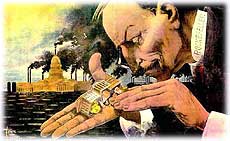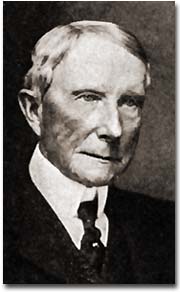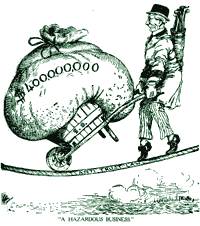36b. The New Tycoons: John D. Rockefeller

"What a Funny Little Government!" Cartoonist Horace Taylor pokes fun at John D. Rockefeller in this cartoon which appeared in The Verdict, a partisan magazine of the day.
He was America's first billionaire.
In a pure sense, the goal of any capitalist is to make money. And John D. Rockefeller could serve as the poster child for capitalism. Overcoming humble beginnings, Rockefeller had the vision and the drive to become the richest person in America.
At the turn of the century, when the average worker earned $8 to $10 per week, Rockefeller was worth millions.
Robber Baron or Captain of Industry?

John D. Rockefeller (1839-1937)
What was his secret? Is he to be placed on a pedestal for others as a "captain of industry?" Or should he be demonized as a "robber baron." A robber baron, by definition, was an American capitalist at the turn of the 19th century who enriched himself upon the sweat of others, exploited natural resources, or possessed unfair government influence.
Whatever conclusions can be drawn, Rockefeller's impact on the American economy demands recognition.
Rockefeller was born in 1839 in Moravia, a small town in western New York. His father practiced herbal medicine, professing to cure patients with remedies he had created from plants in the area. John's mother instilled a devout Baptist faith in the boy, a belief system he took to his grave. After being graduated from high school in 1855, the family sent him to a Cleveland business school.
Young John Rockefeller entered the workforce on the bottom rung of the ladder as a clerk in a Cleveland shipping firm. Always thrifty, he saved enough money to start his own business in produce sales. When the Civil War came, the demand for his goods increased dramatically, and Rockefeller found himself amassing a small fortune.
He took advantage of the loophole in the Union draft law by purchasing a substitute to avoid military service. When Edwin Drake discovered oil in 1859 in Titusville, Pennsylvania, Rockefeller saw the future. He slowly sold off his other interests and became convinced that refining oil would bring him great wealth.
Waste Not...
Rockefeller introduced techniques that totally reshaped the oil industry. In the mid-19th century, the chief demand was for kerosene. In the refining process, there are many by-products when crude oil is converted to kerosene. What others saw as waste, Rockefeller saw as gold. He sold one byproduct paraffin to candlemakers and another byproduct petroleum jelly to medical supply companies. He even sold off other "waste" as paving materials for roads. He shipped so many goods that railroad companies drooled over the prospect of getting his business.
Rockefeller demanded rebates, or discounted rates, from the railroads. He used all these methods to reduce the price of oil to his consumers. His profits soared and his competitors were crushed one by one. Rockefeller forced smaller companies to surrender their stock to his control.
Standard Oil — a Trust-worthy Company?

John D. Rockefeller had to perform a delicate balancing act to maintain his reputation as a philanthropist while living the live of a wealthy businessman.
This sort of arrangement is called a trust. A trust is a combination of firms formed by legal agreement. Trusts often reduce fair business competition. As a result of Rockefeller's shrewd business practices, his large corporation, the Standard Oil Company, became the largest business in the land.
As the new century dawned, Rockefeller's investments mushroomed. With the advent of the automobile, gasoline replaced kerosene as the number one petroleum product. Rockefeller was a bona fide billionaire. Critics charged that his labor practices were unfair. Employees pointed out that he could have paid his workers a fairer wage and settled for being a half-billionaire.
Before his death in 1937, Rockefeller gave away nearly half of his fortune. Churches, medical foundations, universities, and centers for the arts received hefty sums of oil money. Whether he was driven by good will, conscience, or his devout faith in God is unknown. Regardless, he became a hero to many enterprising Americans.





